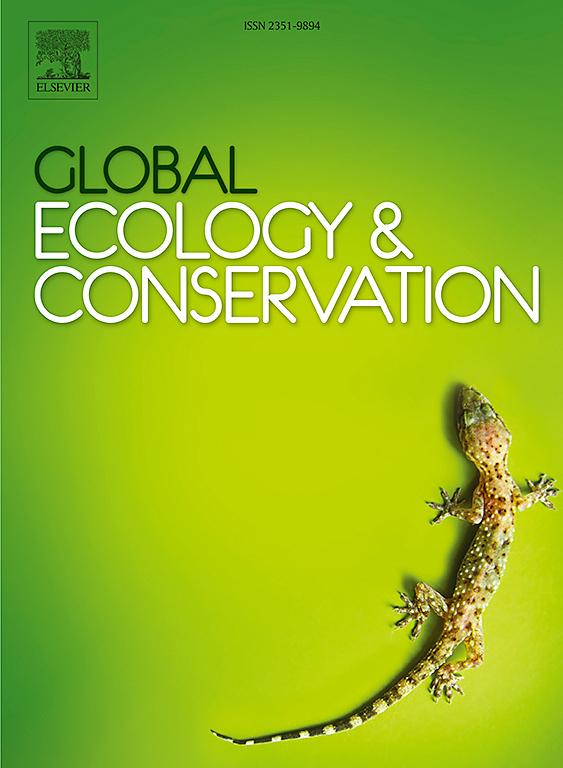The impact of predator exposure and anthropogenic stressors on insect emergence in stream ecosystems
IF 3.5
2区 环境科学与生态学
Q1 BIODIVERSITY CONSERVATION
引用次数: 0
Abstract
Emergence of aquatic insects is a vital ecological process influencing aquatic ecosystems. Predators can modify this process by inducing behavioural and developmental changes in prey species. However, these natural biotic interactions are increasingly disrupted by anthropogenic changes. Anthropogenic stressors, like freshwater salinisation and warming, pose a significant threat to lotic ecosystems worldwide, with effects that may persist even after the stressors are removed. Our study investigated the effects of fish predator exposure (Gasterosteus aculeatus and Cottus rhenanus), increased salinity (ambient vs +136 mg/L NaCl) and increased temperature (ambient vs +3.4 °C) on insect emergence in a controlled stream mesocosm experiment (ExStream system). We monitored the number and size of emerging insects over a 14-day stressor and recovery phase. Predator exposure and elevated salinity reduced the number of emerging insects and resulted in smaller Nematocera emerging. Increased temperature led to reduced body sizes of emerging Nematocera and increased the number of emerging individuals when interacting with increased salinity, predator exposure or both. Notably, the effects of predator exposure were diminished under increased salinity and temperature, although salinity alone reduced the impact on insect size. The stressors did not cause any lasting effect on insect emergence during the recovery phase, except tendentially the size. Our findings highlight that anthropogenic stressors can alter insect emergence and reduce the impact of fish predation, with the magnitude of these effects likely dependent on the intensity and duration of the stressor input.
捕食者暴露和人为应激源对河流生态系统昆虫羽化的影响
水生昆虫的出现是影响水生生态系统的重要生态过程。捕食者可以通过诱导猎物的行为和发育变化来改变这一过程。然而,这些自然的生物相互作用日益受到人为变化的破坏。人为的压力源,如淡水盐碱化和气候变暖,对世界各地的生态系统构成了重大威胁,即使这些压力源被消除,其影响也可能持续存在。在ExStream系统中,研究了不同盐度(环境vs +136 mg/L NaCl)和温度(环境vs +3.4°C)对昆虫出苗的影响。在为期14天的应激和恢复阶段,我们监测了新兴昆虫的数量和大小。捕食者的暴露和盐度的升高减少了新兴昆虫的数量,导致了更小的线虫目的出现。温度升高导致新出现的线虫体型变小,当盐度升高、捕食者暴露或两者同时增加时,新出现的线虫数量增加。值得注意的是,在盐度和温度升高的情况下,捕食者暴露的影响减弱,尽管盐度本身会降低对昆虫大小的影响。在恢复阶段,应激源对昆虫羽化没有持久的影响,但对昆虫羽化大小有一定的影响。我们的研究结果强调,人为压力源可以改变昆虫的出现,减少鱼类捕食的影响,这些影响的程度可能取决于压力源输入的强度和持续时间。
本文章由计算机程序翻译,如有差异,请以英文原文为准。
求助全文
约1分钟内获得全文
求助全文
来源期刊

Global Ecology and Conservation
Agricultural and Biological Sciences-Ecology, Evolution, Behavior and Systematics
CiteScore
8.10
自引率
5.00%
发文量
346
审稿时长
83 days
期刊介绍:
Global Ecology and Conservation is a peer-reviewed, open-access journal covering all sub-disciplines of ecological and conservation science: from theory to practice, from molecules to ecosystems, from regional to global. The fields covered include: organismal, population, community, and ecosystem ecology; physiological, evolutionary, and behavioral ecology; and conservation science.
 求助内容:
求助内容: 应助结果提醒方式:
应助结果提醒方式:


